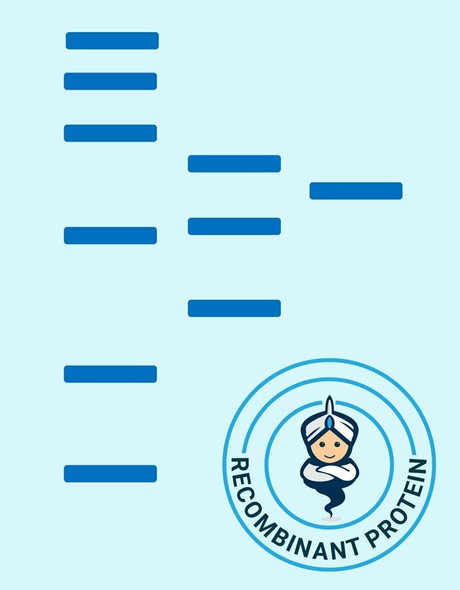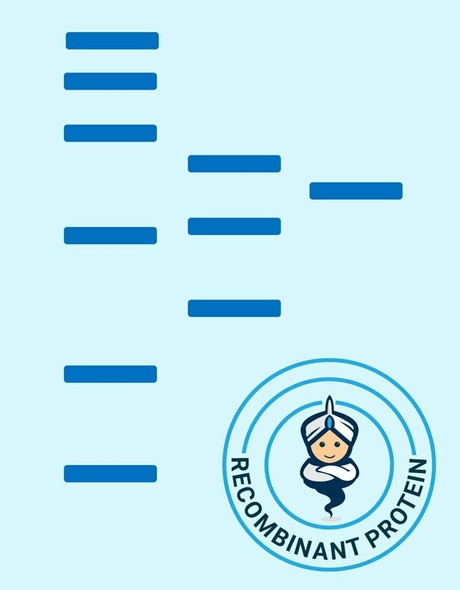Human sRANK Receptor Recombinant Protein (RPPB0918)
- SKU:
- RPPB0918
- Product type:
- Recombinant Protein
- Size:
- 100ug
- Species:
- Human
- Target:
- sRANK Receptor
- Synonyms:
- Tumor necrosis factor receptor superfamily member 11A
- Osteoclast differentiation factor receptor
- ODFR
- Receptor activator of NF-KB
- Source:
- Escherichia Coli
- Uniprot:
- Q9Y6Q6
Description
| Product Name: | Human sRANK Receptor Recombinant Protein |
| Product Code: | RPPB0918 |
| Size: | 100µg |
| Species: | Human |
| Target: | sRANK Receptor |
| Synonyms: | Tumor necrosis factor receptor superfamily member 11A, Osteoclast differentiation factor receptor, ODFR, Receptor activator of NF-KB, FEO, OFE, ODFR, OSTS, PDB2, RANK, CD265, OPTB7, TRANCER, LOH18CR1. |
| Source: | Escherichia Coli |
| Physical Appearance: | Sterile Filtered White lyophilized (freeze-dried) powder. |
| Formulation: | Lyophilized from a 0.2 µm filtered concentrated solution in 20mM Tris-HCl, pH 8.0 and 150mM NaCl. |
| Solubility: | It is recommended to reconstitute the lyophilized sRANK Receptor in sterile 18M-cm H2O not less than 100µg/ml, which can then be further diluted to other aqueous solutions. |
| Stability: | Lyophilized sRANK Receptor although stable at room temperature for 3 weeks, should be stored desiccated below -18°C. Upon reconstitution sRANK Receptor should be stored at 4°C between 2-7 days and for future use below -18°C. For long term storage it is recommended to add a carrier protein (0.1% HSA or BSA).Please prevent freeze-thaw cycles. |
| Purity: | Greater than 98.0% as determined by:(a) Analysis by RP-HPLC.(b) Analysis by SDS-PAGE. |
| Amino Acid Sequence: | QIAPPCTSEK HYEHLGRCCN KCEPGKYMSS KCTTTSDSVC LPCGPDEYLD SWNEEDKCLL HKVCDTGKAL VAVVAGNSTT PRRCACTAGY HWSQDCECCR RNTECAPGLG AQHPLQLNKD TVCKPCLAGY FSDAFSSTDK CRPWTNCTFL GKRVEHHGTE KSDAVCSSSL PARK |
| Biological Activity: | The ED50 as determined by its ability to inhibit sRANK Ligand induced nuclear factor kappa B (NFkappaB) in RAW 264.7 cells is less than 50 ng/ml, corresponding to a specific activity of > 2.0 × 104 IU/mg in the presence of 15 ng/ml of recombinant sRANK Ligand. |
sRANK Receptor is a part of of the TNF superfamily of ligands and receptors which participates in the regulation of specific immunity and bone turnover. sRANK Receptor was originally acknowledged as a dendritic-cell-membrane protein, which by interacting with RANKL augments the capacity of dendritic cells to stimulate naive T cell proliferation and to endorse the survival of RANK and T cells. The full length human RANK cDNA encodes a type I transmembrane protein of 616 amino acids with a predicted 183 amino acid extracellular domain and a 383 amino acid cytoplasmic domain. sRANK Receptor is also expressed in a various tissues including skeletal muscle, thymus, liver, colon, small intestine and adrenal gland.
sRANK Receptor Human Recombinant produced in E.Coli is a single, non-glycosylated polypeptide chain containing 174 amino acids and having a molecular mass of 19.1kDa. The sRANK Receptor is purified by proprietary chromatographic techniques.
| UniProt Protein Function: | TNFRSF11A: Receptor for TNFSF11/RANKL/TRANCE/OPGL; essential for RANKL-mediated osteoclastogenesis. Involved in the regulation of interactions between T-cells and dendritic cells. Binds to the clefts between the subunits of the TNFSF11 ligand trimer to form a heterohexamer. Interacts with TRAF1, TRAF2, TRAF3, TRAF5 and TRAF6. Interacts (via cytoplasmic domain) with GAB2. Ubiquitous expression with high levels in skeletal muscle, thymus, liver, colon, small intestine and adrenal gland. |
| UniProt Protein Details: | Protein type:Membrane protein, integral Chromosomal Location of Human Ortholog: 18q21.33 Cellular Component: external side of plasma membrane; integral to plasma membrane; plasma membrane Molecular Function:cytokine binding; protein binding; receptor activity; transmembrane receptor activity; tumor necrosis factor receptor activity Biological Process: activation of NF-kappaB transcription factor; adaptive immune response; cell-cell signaling; circadian thermoregulation; inflammatory response; osteoclast differentiation; positive regulation of cell proliferation; positive regulation of JNK activity; positive regulation of transcription factor activity; regulation of apoptosis; response to cytokine stimulus; response to lipopolysaccharide; signal transduction; tumor necrosis factor-mediated signaling pathway Disease: Familial Expansile Osteolysis; Osteopetrosis, Autosomal Recessive 7; Paget Disease Of Bone |
| NCBI Summary: | The protein encoded by this gene is a member of the TNF-receptor superfamily. This receptors can interact with various TRAF family proteins, through which this receptor induces the activation of NF-kappa B and MAPK8/JNK. This receptor and its ligand are important regulators of the interaction between T cells and dendritic cells. This receptor is also an essential mediator for osteoclast and lymph node development. Mutations at this locus have been associated with familial expansile osteolysis, autosomal recessive osteopetrosis, and Paget disease of bone. Alternatively spliced transcript variants have been described for this locus. [provided by RefSeq, Aug 2012] |
| UniProt Code: | Q9Y6Q6 |
| NCBI GenInfo Identifier: | 19924309 |
| NCBI Gene ID: | 8792 |
| NCBI Accession: | Q9Y6Q6.1 |
| UniProt Secondary Accession: | Q9Y6Q6,Q59EP9, I4EC36, I4EC38, I4EC39, I7JE63, N0GVH0 |
| UniProt Related Accession: | Q9Y6Q6 |
| Molecular Weight: | |
| NCBI Full Name: | Tumor necrosis factor receptor superfamily member 11A |
| NCBI Synonym Full Names: | TNF receptor superfamily member 11a |
| NCBI Official Symbol: | TNFRSF11A |
| NCBI Official Synonym Symbols: | FEO; OFE; ODFR; OSTS; PDB2; RANK; CD265; OPTB7; TRANCER; LOH18CR1 |
| NCBI Protein Information: | tumor necrosis factor receptor superfamily member 11A |
| UniProt Protein Name: | Tumor necrosis factor receptor superfamily member 11A |
| UniProt Synonym Protein Names: | Osteoclast differentiation factor receptor; ODFR; Receptor activator of NF-KB; CD_antigen: CD265 |
| UniProt Gene Name: | TNFRSF11A |










